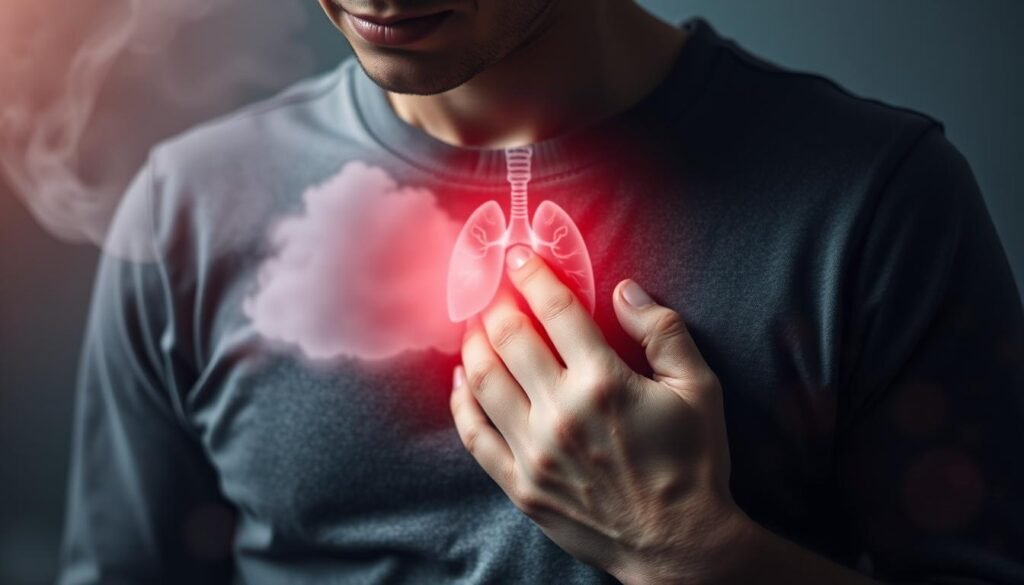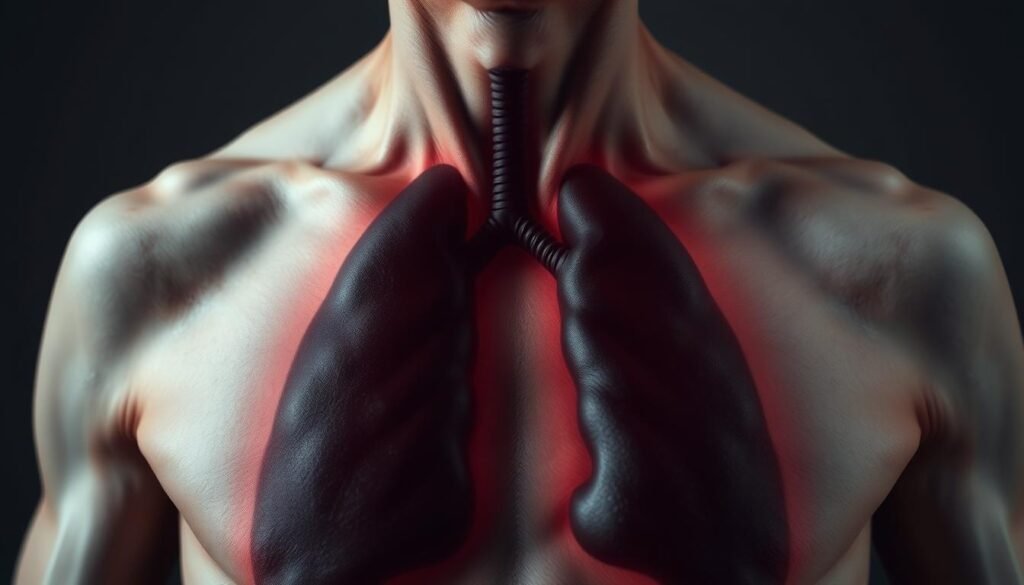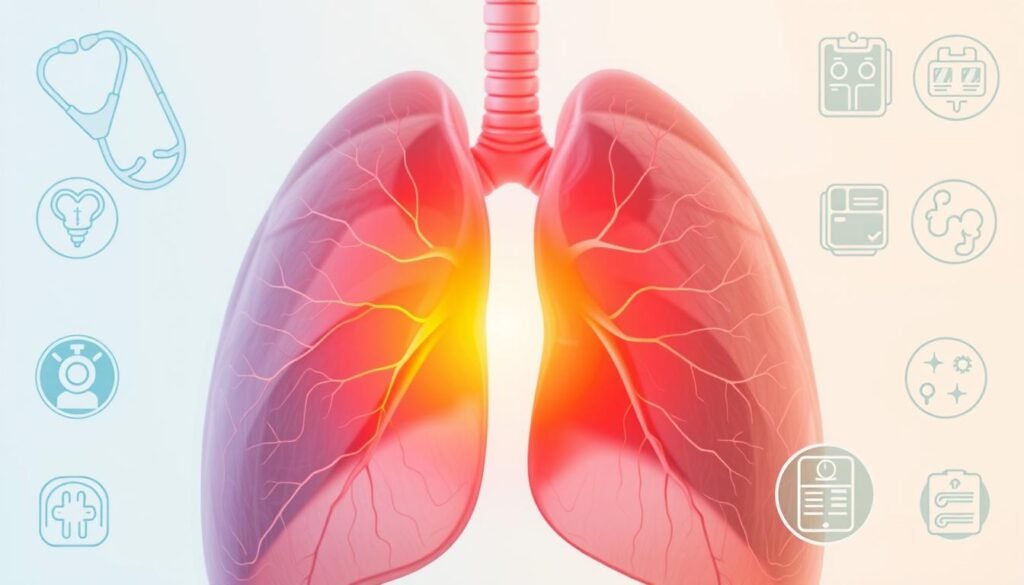Did you know about 80% of people with finger clubbing could have lung cancer? This condition makes fingertips larger and is a big warning sign. Spotting lung cancer’s early symptoms is key to fight the disease effectively.
A persistent cough or coughing up blood can signal lung cancer. These signs can also mean other health problems. It’s vital to see a doctor fast if you notice these symptoms. Early detection can make a huge difference in treatment success.
Key Takeaways
- Around 80% of those with finger clubbing may have lung cancer.
- Persistent cough lasting over eight weeks is a common symptom.
- Coughing up blood, even in small amounts, should be taken seriously.
- Chest pain during deep breaths or coughing could indicate lung issues.
- Recognizing symptoms early can lead to earlier diagnosis and treatment.
Understanding Lung Cancer
Lung cancer causes many deaths around the world. It starts in the lungs and may not show signs at first. Finding it early is key to better treatment results. This is because it’s often found late.
Lung cancer is mainly of two types: non-small cell (NSCLC) and small cell (SCLC). NSCLC is more common and often less serious than SCLC. SCLC usually affects long-time smokers. Lung cancer statistics show smoking is a major cause. Secondhand smoke and pollutants also play big roles.
Family history and working with dangerous substances like asbestos add to the risk. Radon gas in homes can be harmful too. Knowing these risks can help in preventing the disease. It’s important because late-stage symptoms mean the cancer may have spread. Early diagnosis and screening are crucial.
Quitting smoking helps lower your risk, but there’s no sure way to prevent lung cancer. Care from a team of experts helps find the best treatment. This shows why early detection is vital for better health.
Types of Lung Cancer
Lung cancer is mainly divided into two types: non-small cell lung cancer (NSCLC) and small cell lung cancer (SCLC). They grow differently, have different treatments, and different survival rates.
Non-small cell lung cancer is the most common, making up 85% of cases. It grows slower than small cell lung cancer. NSCLC includes several subtypes:
- Adenocarcinoma
- Squamous cell carcinoma
- Large cell carcinoma
On the other hand, small cell lung cancer is less common but very aggressive. It spreads fast, so catching it early is key.
It’s important to know the types of lung cancer to spot the signs early. Many treatments are available:
| Treatment Option | Applicable Cancer Type | Description |
|---|---|---|
| Surgery | NSCLC, SCLC (limited stage) | Involves removing part of the lung if the cancer hasn’t spread much. |
| Radiofrequency Ablation (RFA) | NSCLC | Uses heat to kill cancer cells in tumors at the lung’s edge. |
| Chemotherapy | NSCLC, SCLC | Drugs are used to stop cancer cells from growing. |
| Targeted Drug Therapy | NSCLC | Attacks specific parts of cancer cells to kill them. |
| Immunotherapy | NSCLC, SCLC | Helps your immune system fight the cancer better. |
Knowing about lung cancer helps you catch it early and get treatment sooner.
Early Warning Signs of Lung Cancer
Spotting early signs of lung cancer can greatly improve treatment results. Symptoms often show up slowly and are easy to miss. This could lead to big delays in finding out what’s wrong. Some key signs should make people take notice.
Persistent Cough
If a cough doesn’t get better with time, it’s a warning sign. Such coughs may get worse and come with other worrying signs. If you notice a cough like this, especially with blood or rust-colored spit, it’s serious. Coughing blood is a red flag that needs quick doctor’s check.
Coughing Up Blood
Coughing up blood is a scary sign of lung cancer. It might be just a little blood in your spit or a lot. Either way, it means you need to see a doctor fast. It could mean cancer or other serious lung problems.
Chest Pain
Chest pain is another serious symptom to watch for. It can happen with a deep breath, cough, or even laughter. This pain might mean something’s blocking your lung or there’s fluid around it, maybe from a tumor. If your chest hurts for no clear reason, get it checked out.
Other Common Symptoms
Early detection of lung cancer is key, and knowing other signs is crucial. Sometimes, people don’t feel symptoms until the cancer grows. Yet, early signs like shortness of breath, wheezing, and fatigue need attention. They can be easily missed or thought to be something else.
Shortness of Breath
Having trouble breathing, even with light activities, is a common early sign. It shows your lungs might not be working right. This is worrying, especially if it starts suddenly or gets worse for no clear reason.
Wheezing
Wheezing means there’s a whistling sound when you breathe. It can mean your airways are blocked or have other problems. Though often linked to asthma, wheezing can also be a lung cancer sign. It’s important to check it out.
Fatigue
Fatigue is when you feel weak all the time, and it’s hard to explain why. It’s a common issue for those with lung cancer, making everyday tasks hard. If you’re always tired, it might be more than just normal tiredness. It could be a sign to see a doctor.

Weight Loss and Loss of Appetite
Unexplained weight loss is a big warning sign for serious health issues, like lung cancer. People with lung cancer often eat less. This makes them lose weight without trying. The body needs more energy when fighting cancer, but they can’t eat enough.
Many cancer patients, up to 80%, get cachexia. This means they lose a lot of weight and muscle. Sadly, one-third of these patients die from it. Treatments like chemotherapy and radiation make it worse by causing nausea. Radiation near the stomach or head makes eating hard.
Seeing a doctor is smart if you lose more than 5% of your weight in 6 to 12 months without trying. This can be a first sign of lung cancer and other diseases. Being aware of these signs is important.
Knowing about symptoms like not wanting to eat can help catch lung cancer early. For more info on lung cancer symptoms, check out this resource. Quick action on weight loss can guide to the right treatment.
Recognizing Severe Symptoms
It’s vital to know the severe signs of lung cancer for early detection and action. Recognizing these symptoms helps people get medical help sooner, especially with advanced stages.
Bone Pain and Nerve Issues
Lung cancer can cause bone pain when it spreads to bones. This pain mainly affects the back or hips. People may also feel headaches or numbness, showing brain or nerve impact.
It’s important to watch out for these pains and sensations. They could mean the condition is getting worse and needs quick medical care.
Jaundice
Watch for jaundice, shown by yellow skin and eyes. It often means the liver is affected by the cancer. Spotting jaundice is crucial for getting fast medical checks and care.

Infections Related to Lung Cancer
Lung cancer can lead to many complications, including infections. People with lung cancer are more likely to get infections such as bronchitis and pneumonia. These infections often come back because the disease weakens the lungs or the immune system.
Bronchitis causes swelling and irritation in the airways, leading to a constant cough and breathing troubles. It’s especially concerning for those with lung cancer, as it may hint at deeper lung problems. Pneumonia, which inflames the air sacs in the lungs, is also a big risk. Frequent pneumonia episodes can mean lung function is getting worse, complicating treatment.
When infections don’t respond to treatments, it might mean lung cancer is present. Doctors should test for cancer if someone keeps getting respiratory infections. It’s important to see the connection between infections and lung cancer because it could point to the cancer getting worse.
| Type of Infection | Symptoms | Potential Impact on Lung Cancer |
|---|---|---|
| Bronchitis | Coughing, chest discomfort, fatigue | May worsen lung function and increase coughing |
| Pneumonia | Fever, chills, difficulty breathing | Increases risk of complications in lung cancer |
| Infections | Fever, persistent cough, fatigue | May indicate cancer progression |
The Importance of Early Detection
Early detection is key in fighting lung cancer. Finding it early greatly improves chances of successful treatment and survival. Only 21% of lung cancers are caught early, when they’re easiest to treat. Catching lung cancer early can lead to a much better chance of living five years or more after finding it.
If you’re at high risk, getting screened is crucial. This includes people 50 to 80 years old who have a history of smoking for at least 20 pack-years. Following the US Preventive Services Task Force (USPSTF) guidelines, they should get a yearly check-up. Talking to your doctor about getting screened is important. It helps you understand if it’s right for you and keeps an eye on any risk factors.

A low-dose CT scan is the top choice for checking for lung cancer. It’s better than old chest X-rays because it shows clearer pictures. This makes it easier to spot any problems. However, there are downsides to these scans, like radiation exposure and the stress of waiting for results. Knowing the pros and cons helps patients make the best choice for their health.
Raising awareness about early detection and available screenings is crucial. It encourages people to be proactive about their health. We must find a balance between being careful and making informed decisions to fight lung cancer effectively.
For more information on lung cancer screening guidelines, visit lung cancer detection resources.
When to See a Doctor
Knowing when to get medical help is key for lung cancer outcomes. Acting fast when you notice lung cancer symptoms is crucial. Don’t ignore a persistent cough. If it doesn’t go away in a few weeks, you should see a doctor.
Losing over ten pounds without trying is a red flag. It might mean something serious, like cancer. Chest pain that gets worse when you breathe deeply or cough also needs checking.
- Chronic cough lasting eight weeks or longer
- Shortness of breath after minimal exertion
- Coughing up blood or rust-colored sputum
- Recurrent respiratory infections
- Persistent fatigue without obvious cause
Knowing these health concerns can help catch lung cancer early. Lung cancer kills more people each year than breast, colon, and prostate cancer combined. Recognizing early signs is vital.
Documenting your symptoms accurately helps doctors diagnose and treat you. Some places offer free screenings for those hard to reach healthcare. Taking steps early can make a big difference in fighting lung cancer.
Conclusion
Knowing the signs of lung cancer is key for anyone focused on their health. It’s a top cause of cancer deaths in the U.S., affecting many globally. Spotting symptoms like a constant cough, unexpected weight loss, and feeling tired allows people to get help early. This early detection is key to better treatment results and living longer.
Symptoms like a rough voice and ongoing tiredness may mean lung cancer is getting worse. This calls for a quick visit to the doctor. The note on lung cancer symptoms shows why it’s crucial to watch your health closely. Knowing how this illness shows up helps people take action fast. This is especially important for fast-moving types of lung cancer.
About 2.2 million new lung cancer cases are found each year. Spreading the word on the symptoms can create a society more aware of its health. For details on spotting early signs and what lung cancer means, people can look online. A good place to start is this guide on early warning signs of metastatic lung cancer. Being well-informed can lead to quick actions that may save lives.